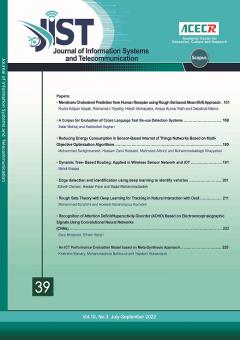-
-
List of Articles
-
Open Access Article
1 - Membrane Cholesterol Prediction from Human Receptor using Rough Set based Mean-Shift Approach
Rudra Kalyan Nayak Ramamani Tripathy Hitesh Mohapatra Amiya Kumar Rath Debahuti Mishra -
Open Access Article
2 - A Corpus for Evaluation of Cross Language Text Re-use Detection Systems
Salar Mohtaj Habibollah Asghari -
Open Access Article
3 - Reducing Energy Consumption in Sensor-Based Internet of Things Networks Based on Multi-Objective Optimization Algorithms
Mohammad sedighimanesh Hessam Zandhessami Mahmood Alborzi Mohammadsadegh Khayyatian -
Open Access Article
4 - Dynamic Tree- Based Routing: Applied in Wireless Sensor Network and IOT
Mehdi Khazaei -
Open Access Article
5 - Edge Detection and Identification using Deep Learning to Identify Vehicles
Zohreh Dorrani Hassan Farsi Sajad Mohammadzadeh -
Open Access Article
6 - Rough Sets Theory with Deep Learning for Tracking in Natural Interaction with Deaf
Mohammad Ebrahimi Hossein Ebrahimpour-Komeleh -
Open Access Article
7 - Recognition of Attention Deficit/Hyperactivity Disorder (ADHD) Based on Electroencephalographic Signals Using Convolutional Neural Networks (CNNs)
Sara Motamed Elham Askari -
Open Access Article
8 - An ICT Performance Evaluation Model based on Meta-Synthesis Approach
Khatrehe Bamary Mohammad Reza Behboudi Tayebeh Abbasnjad
-
The rights to this website are owned by the Raimag Press Management System.
Copyright © 2017-2025







